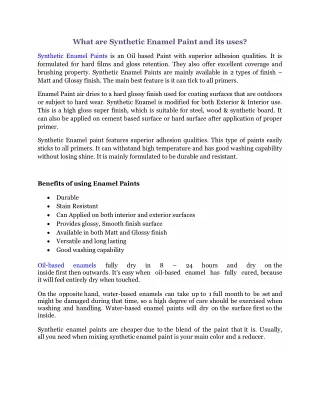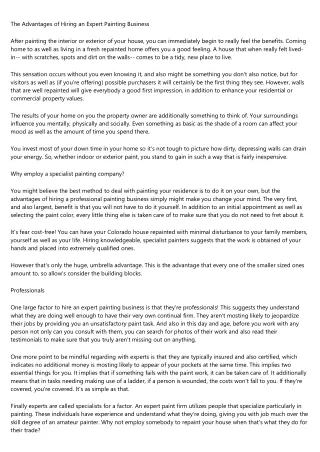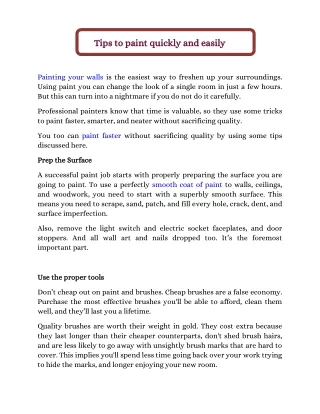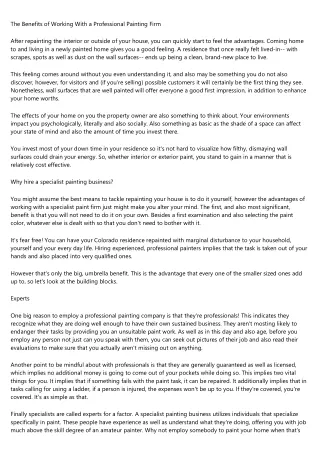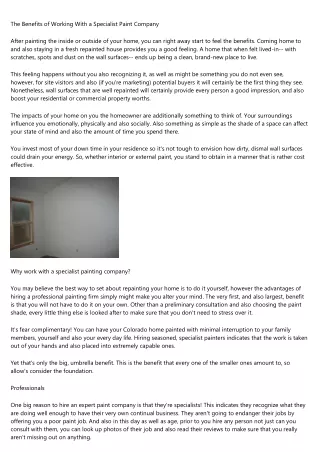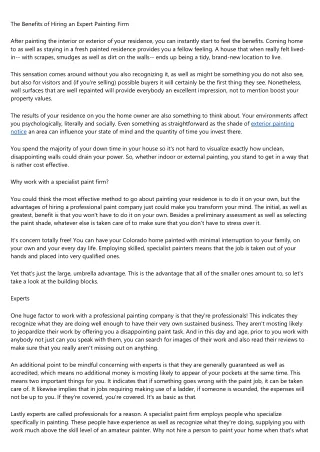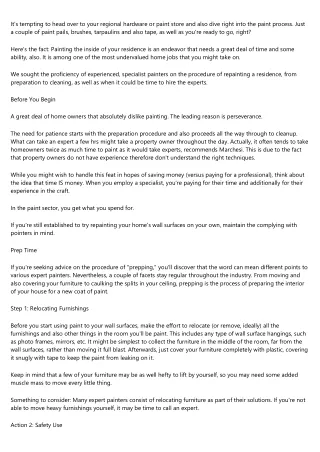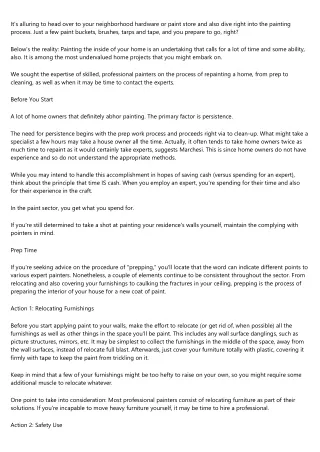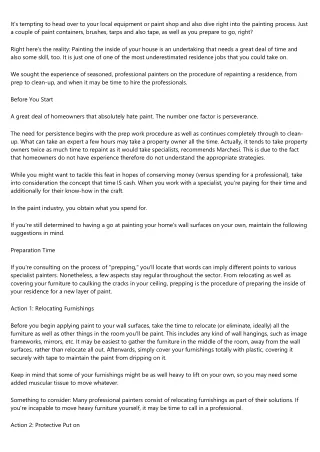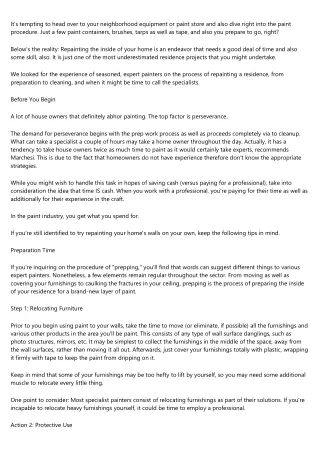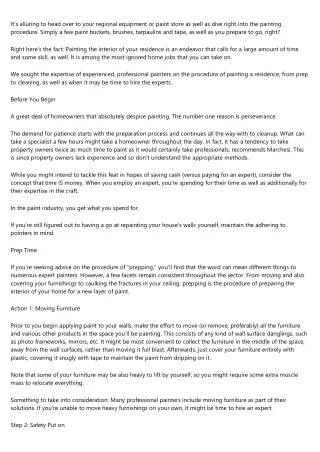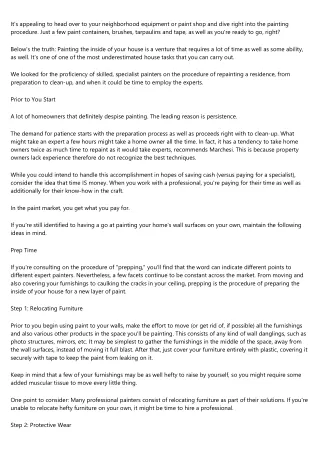Considering Painting Your Home Yourself? Right here Is A Word to the Wise About Do It Yourself Interior Painting ( as
It's appealing to head over to your local equipment or paint shop and also dive right into the painting process. Simply a few paint buckets, brushes, tarps as well as tape, and also you prepare to go, right? Below's the reality: Repainting the inside of your house is an undertaking that calls for a great deal of time and also some skill, as well. It is among the most taken too lightly home jobs that you could take on. We sought the expertise of seasoned, expert painters on the procedure of repainting a residence, from preparation to cleaning, and when it might be time to employ the specialists. Prior to You Start A lot of house owners that absolutely despise paint. The leading factor is perseverance. The requirement for persistence starts with the preparation process and continues completely via to cleanup. What might take a specialist a couple of hrs might take a property owner all the time. Actually, it often tends to take homeowners two times as much time to paint as it would take specialists, recommends Marchesi. This is due to the fact that home owners lack experience and so do not know the right strategies. While you might intend to take on this accomplishment in hopes of saving cash (versus paying for an expert), think about the concept that time IS cash. When you hire a specialist, you're paying for their time as well as likewise for their competence in the craft. In the paint sector, you obtain what you pay for. If you're still figured out to try painting your home's wall surfaces yourself, maintain the following pointers in mind. Prep Time If you're seeking advice on the procedure of "prepping," you'll discover that the word can imply various things to various specialist painters. However, a few elements stay regular throughout the market. From moving as well as covering your furniture to caulking the splits in your ceiling, prepping is the procedure of preparing the inside of your home for a new coat of paint. Action 1: Moving Furnishings Prior to you begin applying paint to your walls, make the effort to move (or remove, ideally) all the furnishings as well as various other products in the room you'll be paint. This consists of any kind of wall surface danglings, such as picture frameworks, mirrors, and so on. It may be easiest to gather the furniture in the middle of the room, far from the walls, as opposed to moving it all out. Afterwards, just cover your furniture completely with plastic, covering it tightly with tape to keep the paint from dripping on it. Keep in mind that several of your furniture might be as well hefty to raise by yourself, so you may need some extra muscle mass to move whatever. One thing to think about: The majority of professional painters include moving furniture as part of their services. If you're incapable to relocate heavy furnishings yourself, it might be time to call an expert. Step 2: Safety Use Equally as you applied to safeguard your furnishings, take some time to secure yourself. Many expert painting and decoration companies recommend utilizing goggles for correct eye protection. Furthermore, put on clothes you will not mind ruining, just in case you drip paint on yourself. If you're planning on fining sand, think about utilizing a facemask to shield your lungs from breathing in dirt and also debris. Action 3: Tidy as well as Fix the Walls A great wall surface cleansing is highly recommended, before a layer of paint. Take some time to clean and also cleanse your wall surfaces before paint. For shower rooms as well as kitchens (surfaces that tend to build up dirt), utilize 3 tsps of laundry cleaning agent to a gallon of water. Put on the walls with an old towel or dustcloth. Step 4: Look For and also Fix Flaws Take the time to search for flaws in your wall surfaces, such as nail holes, damages as well as splits. Depending on the dimension of the area, this step may take longer than you expect. Some professionals utilize a halogen light as well as move up as well as down the wall surfaces to capture the least flaw. That's something that home owners may not think of. They may not want to make the effort to patch unless it's a nail opening from a picture, yet there's a whole lot more to it. Even the tiniest shadow or the sunlight radiating right up against a wall is mosting likely to expose any type of imperfection. You need to likewise remove any kind of cracked or flaking paint leftovers. A routine paint scrape and sandpaper or an electric sander are usually used for minor imperfections like plastering bumps. Similar to relocating furnishings, most expert painting firms offer this service. By making the effort to deal with every defect in your wall, you'll make sure that your paint work has the top quality and also durability that you're looking for. Step 5: Insulation and Tarps You knew it was coming: the dreaded painter's tape. This step will certainly more than likely take the bulk of your prep time. " If you want straight lines on your ceiling, wall surfaces and trim, tape every little thing out," Marchesi recommends. "It takes a little time, however you improve outcomes." Make sure to safeguard any lighting sconces, home window frames and also lighting components prior to you paint. This can be finished with painter's tape or tin aluminum foil. Tin aluminum foil is advantageous with harder-to-cover surfaces in your house, like illumination sconces and also door manages. Cover it around the whole surface as well as mold and mildew its form to the things it's covering. Because you never ever recognize where paint may go, lay down a tarp to keep your carpet and also flooring paint-free. Most professional and also seasoned painters don't require to tape before they repaint, which is one reason they're a lot faster than the typical home owner. Devices for the Task Now it's time to review the tools of the trade favored by the specialists themselves. From premium to inexpensive, devices range in cost, but the vital concept to bear in mind is that you get what you pay for. To begin, here are some of one of the most basic products you'll need for prepping: Spot blades (6, 8 or 12 inches). Patch or caulk. Sandpaper or an electric sander. Safety eyeglasses. Facemask. After you've repaired any type of holes or problems in your ceiling, walls and trim, these are the items you'll require to start paint:. Can opener. Repaint canisters. Stirrers. Roller covers. Brushes (in a range of sizes). Trays. Dustcloths or old towels. Expansion post. Painter's tape. Repaint spout. The majority of experts choose Wooster brand name paint brushes. Wooster has various designs of brushes that are good for trim. Use a soft brush for trim; the softer the bristle, the far better paint flow on the trim. For wall surfaces and also ceiling, utilize an added company brush. Rates for Wooster gets on the higher end, as they're higher quality brushes. If you're looking to be cost-efficient, Home Depot has actually a brand name called Purdy. It's less expensive than Wooster but still a quality brush. There are likewise brushes that you can throw out after one use. This path is useful, particularly for house owners because they're decent-quality brushes that can be purchased at any paint or equipment store for an affordable price and after that conveniently gotten rid of after the job. Professionals' Preferred Paint Brands. With thousands of different paint brand names on the market, exactly how do you understand which is the appropriate one for you? Rate as well as top quality vary, so it's great to do your research. The majority of expert painter's preferred paint brand is Benjamin Moore. They are a better company that's higher in quality. In the paint sector, you obtain what you spend for. If you intend to buy something affordable that will last a pair years, after that you'll want to go with a lower line. But you certainly get what you spend for. Certainly there are a lot more affordable brand names on the marketplace, such as Behr, one of one of the most popular brand names for Do It Yourself exterior and interior painting projects. Behr can be located at your neighborhood hardware or paint store. Sherwin-Williams is in the center in terms of price and may be an excellent choice for you as well. Just How Much Paint You'll Require. Next off, figure out just how much paint you need for your job. Step the square feet of the space you're intending to paint. One gallon of paint usually covers 450 square feet of area. When it involves choosing an appropriate color for your space, test the colors on the wall surfaces prior to you paint the entire wall. Do not trust impacts as well as make decisions based on in-store color swatches. There are lots of aspects that influence your final result. Ensure you take indoor lighting right into complete consideration. Testing your paint is required. Examples never ever reflect the actual shade of the finished paint job. To Prime or otherwise to Prime? A lot of individuals like to prime the whole room. It is generally unneeded, specifically with paint now-a-days in which you locate guide in it currently. However, if you're mosting likely to do a lighter paint shade over a darker existing paint color, it'll reveal through, even after two layers. That's when you intend to prime. See to it you select the ideal guide. A water-based primer is typically utilized for drywall, while oil-based primer would be applied to stain-covered walls or panel setups. Tint your guide to the shade you plan on using on the wall surfaces, so you can prime and also lay your first layer at the same time. You can have a specialist tint your primer at any paint or hardware store. Paint Order. Begin at the highest point of the area, which is your ceiling, as well as work your method down to the trim and afterwards the walls. The instructions on paint canisters generally advise waiting four to 6 hours between layers of paint. Marchesi advises accelerating the process by "forced drying out," which indicates having a fan blow on the painted walls to dry them much faster. Depending upon the amount of "forced air" you have blowing on the wall surface, you might perhaps do a second coat after simply 2 hrs. A Word Concerning Trim. Trim can be recognized as base molding, home window molding and also crown molding commonly found in the form of timber, plastic or stone. If those aspects exist and also have actually been repainted previously, it might require to be refurbished. Marchesi explained his procedure for painting trim:. Make the effort to consider every fracture as well as caulk it. If there's any sort of hole or nick, fill that in with a patch and also sand it down. Utilize a damp sanding strategy to maintain the dirt from dropping all over the place. A lot of homeowners like that. Then, 2 coats of paint over top of it is constantly the very best look. Strategy (Idea). You might have heard of the "W" or "V" technique to roll paint on a wall surface. The procedure is basically like this:. Start from the corner of the wall surface and roll on a three-inch by three-inch 'W.' After that, load it in without lifting the roller. Repeat up until you fill the whole 'W' in. This method is made use of to conceal seams and also areas where the roller call was lost or placed once again. Some specialists suggested using the elastic band trick while you're functioning:. Put a rubber band around the paint can so you have something to cleanly scratch excess paint off your brush. You don't want to scratch it versus the can's opening since the paint will permeate right into the seal, making it more difficult to close. The rubber band will certainly additionally simply leak the excess paint back right into the container, limiting your waste of paint. The Clean-Up Refine. There are a few different things to take into consideration when cleaning up after painting. Initially, do not tidy oil paints in a sink. You have to utilize thinner to tidy up your gear as well as brushes. This will certainly require you to cleanse your gear in a different receptacle, like a disposable tub or plastic pail, full of any cleaning representatives, like soap as well as water or laundry cleaning agent. The thinner can not be taken care of curbside. Learn just how your city deals with disposal of paint thinners and also where you can kip down the bucket of thinner to be dealt with properly by an expert. You can deal with paint via curbside trash pickup, however you need to add a drying out agent to the paint before putting it out. Drying out agents consist of pet cat trash as well as sand to take in any type of staying paint. The paint covers should additionally be gotten rid of. Nonetheless, if you 'd rather maintain your added products as well as paint, clean the brushes in a conditioner mix. By blending two tbsps of fabric softener and also cozy water, you can develop an overnight soak that will certainly raise dried out on paint to be scrubbed off the following day.
62 views • 6 slides





